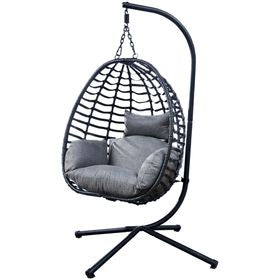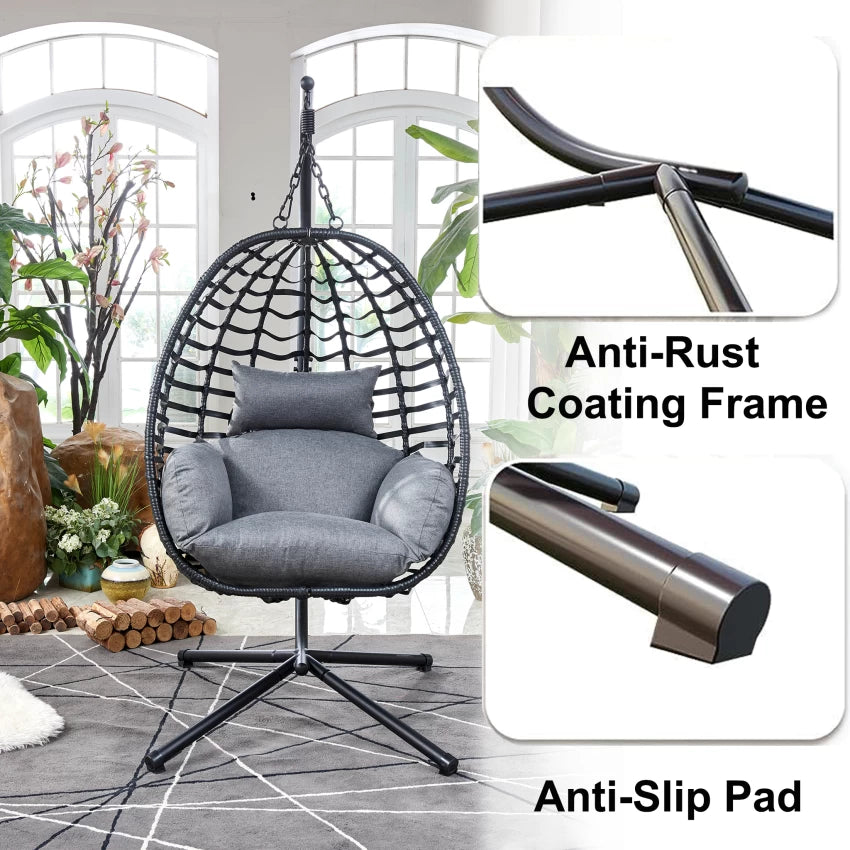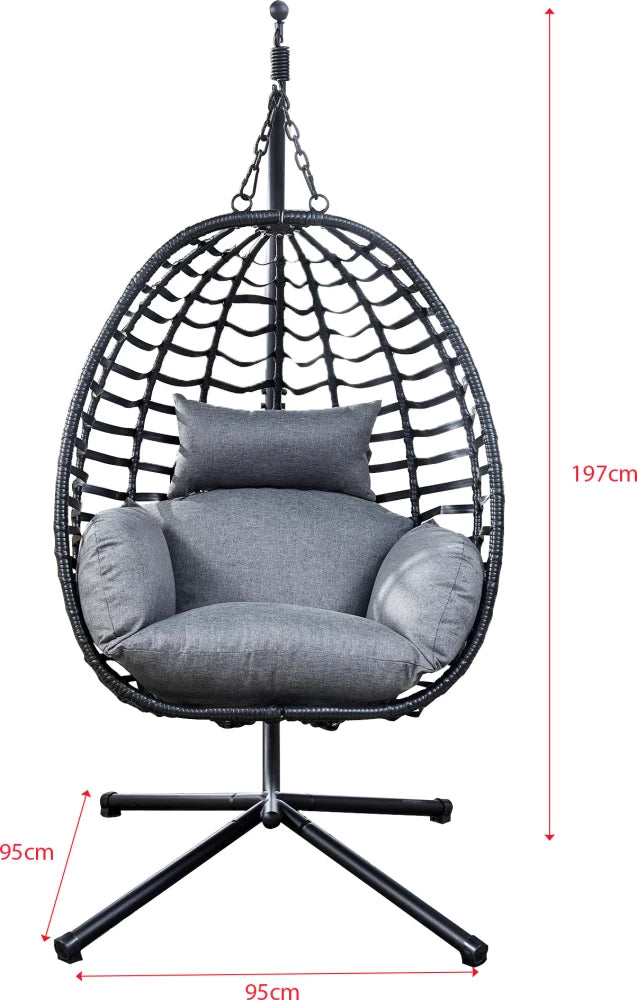Lu Belo Home
Ashdown Outdoor Hanging Egg Chair with Red Cushion | Durable & Stylish 2025
Ashdown Outdoor Hanging Egg Chair with Red Cushion | Durable & Stylish 2025
Couldn't load pickup availability
Comparison of Outdoor Furniture Materials
Outdoor furniture comes in a variety of materials, each offering unique benefits and trade-offs in terms of durability, maintenance, cost, and style. The best choice depends on your climate, budget, and how much upkeep you’re willing to handle. For instance, humid or rainy areas favor rust-resistant options like aluminum or synthetic wicker, while dry climates suit woods like teak. Below, I’ll compare the most popular materials based on key factors, drawing from expert guides and reviews. I’ve focused on common types like wood, metal (aluminum, steel, wrought iron), wicker/rattan (natural and synthetic), plastic/resin, and recycled materials.
Key Comparison Table
|
Material |
Durability & Weather Resistance |
Maintenance |
Cost |
Style & Comfort |
Pros |
Cons |
|
Wood (e.g., Teak, Acacia, Eucalyptus) |
High; naturally resistant to rot, insects, and extreme weather if sealed. Teak excels in varying climates. |
Medium; requires annual sealing/oiling to prevent fading or cracking. |
Medium to High ($500–$2,000 per set) |
Warm, natural rustic look; comfortable with cushions. Doesn’t heat up like metal. |
Eco-friendly (sustainable sourcing); ages beautifully; versatile designs. |
Can warp in humidity; susceptible to termites without treatment; heavy to move. |
|
Aluminum |
Excellent; rust-proof, lightweight, holds up in wind/rain/UV. Ideal for coastal or humid areas. |
Low; wipe down occasionally; no rust worries. |
Medium ($400–$1,500 per set) |
Modern, sleek; powder-coated for color options. |
Easy to move; versatile shapes; doesn’t fade or corrode. |
Can get hot in direct sun; lower-end versions have weak welds. |
|
Steel/Wrought Iron |
Very high; sturdy against wind, but steel can rust if not coated. Wrought iron is ornate and long-lasting. |
Medium; rust-proof coatings need touch-ups; clean with soapy water. |
Medium to High ($600–$2,000 per set) |
Classic, elegant (wrought iron); industrial vibe (steel). |
Heavy and stable; eco-friendly (often recycled); unique handmade designs. |
Heavy to rearrange; can chip or rust in salty air; gets very hot. |
|
Synthetic Wicker/Rattan (Resin/Polyethylene) |
Excellent; UV/fade-resistant, waterproof; mimics natural look without fragility. |
Low; hose off; mildew-resistant. |
Low to Medium ($300–$1,000 per set) |
Casual, bohemian; lightweight and stackable. |
Affordable; all-weather; easy to clean; eco-options from recycled plastics. |
Can look cheap if low-quality; lightweight in wind; may off-gas VOCs initially. |
|
Plastic/Resin (e.g., HDPE) |
Good; fully weatherproof, won’t crack in cold/heat. |
Very Low; UV-treated to prevent fading. |
Low ($200–$800 per set) |
Simple, colorful; Adirondack-style options. |
Budget-friendly; portable; recyclable. |
Feels less premium; can blow over in wind; absorbs heat. |
|
Recycled Plastic/Composite |
High; made from bottles/jugs; resists moisture and insects. |
Low; no sealing needed. |
Medium ($400–$1,200 per set) |
Eco-modern; mimics wood without upkeep. |
Sustainable; durable in all climates; non-toxic if HDPE-based. |
Initial off-gassing smell in heat; limited color variety. |
Detailed Breakdown by Category
1. Durability and Weather Resistance
- Top Performers: Aluminum and synthetic wicker shine in harsh conditions like rain, snow, or salt air, with no rust or rot issues. Teak wood is a natural standout for its oils that repel water.
- Weaker Options: Natural wicker or untreated wood can mildew or splinter in humidity; plastic holds up but may fade without UV protection. Steel needs powder-coating to avoid corrosion. In extreme climates, prioritize rust/corrosion-resistant picks to avoid frequent replacements.
2. Maintenance and Longevity
- Easiest: Aluminum, synthetic materials, and recycled plastics require minimal effort—just occasional cleaning. They can last 10–20+ years outdoors.
- More Involved: Woods like eucalyptus need refinishing every 1–2 years; wrought iron benefits from rust inhibitors. Expect 5–15 years of life with proper care. Low-maintenance is key if you lack storage for winter.
3. Cost and Value
- Budget-Friendly: Plastic and synthetic wicker offer great entry-level value without sacrificing usability.
- Investment Pieces: Teak or wrought iron justify higher upfront costs with decades of use. Factor in longevity—cheaper plastics might need replacing sooner, eroding savings.
4. Style, Comfort, and Sustainability
- Aesthetic Variety: Wood for timeless warmth, metals for contemporary edge, wicker for relaxed vibes. Pair with weatherproof cushions (acrylic or Sunbrella fabric) for comfort.
- Eco Angle: Opt for FSC-certified teak, recycled HDPE, or steel from post-consumer sources to minimize environmental impact. Avoid PVC-heavy plastics due to off-gassing.
Recommendations
- For Low-Maintenance Patios: Go with aluminum or synthetic wicker—perfect for busy homeowners in variable weather.
- For Luxe, Natural Feel: Teak sets the standard but seal it annually.
- Budget or Eco-Focused: Recycled plastic provides durability without the premium price.
Ultimately, assess your space: Measure for fit, test for comfort in-store, and use covers for protection. This ensures your outdoor oasis stays inviting year-round. If you have a specific type (e.g., chairs vs. tables) or climate in mind, I can refine this further!






